
The Uffizi Gallery is a prominent art museum located adjacent to the Piazza della Signoria in the Historic Centre of Florence in the region of Tuscany, Italy. One of the most important Italian museums and the most visited, it is also one of the largest and best known in the world and holds a collection of priceless works, particularly from the period of the Italian Renaissance.
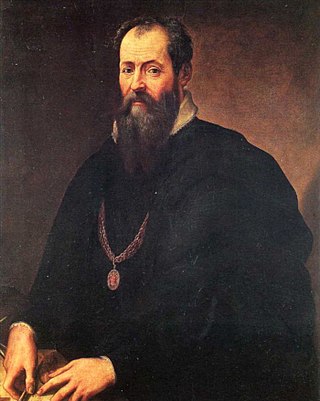
Giorgio Vasari was an Italian Renaissance Master, who worked as a painter, architect, engineer, writer, and historian, who is best known for his work The Lives of the Most Excellent Painters, Sculptors, and Architects, considered the ideological foundation of all art-historical writing, and the basis for biographies of several Renaissance artists, including Leonardo da Vinci and Michelangelo. Vasari designed the Tomb of Michelangelo in the Basilica of Santa Croce, Florence that was completed in 1578. Based on Vasari's text in print about Giotto's new manner of painting as a rinascita (rebirth), author Jules Michelet in his Histoire de France (1835) suggested adoption of Vasari's concept, using the term Renaissance to distinguish the cultural change. The term was adopted thereafter in historiography and still is in use today.
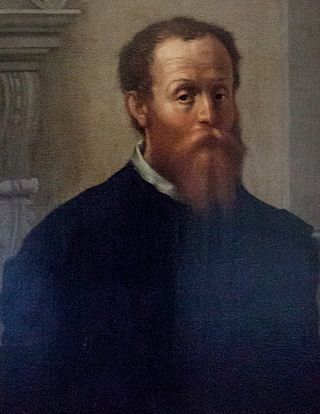
Baccio Bandinelli, was an Italian Renaissance sculptor, draughtsman, and painter.

Cosimo I de' Medici was the second Duke of Florence from 1537 until 1569, when he became the first Grand Duke of Tuscany, a title he held until his death.
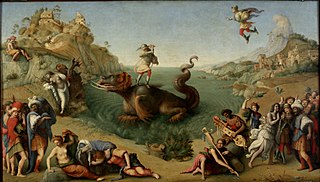
Piero di Cosimo, also known as Piero di Lorenzo, was an Italian painter of the Renaissance.

The Palazzo Vecchio is the town hall of Florence, Italy. It overlooks the Piazza della Signoria, which holds a copy of Michelangelo's David statue, and the gallery of statues in the adjacent Loggia dei Lanzi.

Agnolo di Cosimo, usually known as Bronzino or Agnolo Bronzino, was an Italian Mannerist painter from Florence. His sobriquet, Bronzino, may refer to his relatively dark skin or reddish hair.

Bernardo Buontalenti, byname of Bernardo Delle Girandole, was an Italian stage designer, architect, theatrical designer, military engineer and artist and inventor of italian ice cream.

The Vasari Corridor is an elevated enclosed passageway in Florence, central Italy, connecting the Palazzo Vecchio with the Palazzo Pitti. Beginning on the south side of the Palazzo Vecchio, it joins the Uffizi Gallery and leaves on its south side, crossing the Lungarno dei Archibusieri, then following the north bank of the River Arno until it crosses the river at Ponte Vecchio. At the time of construction, the corridor had to be built around the Torre dei Mannelli, using brackets, because the tower's owners refused to alter it. The corridor conceals part of the façade of the Church of Santa Felicità. It then snakes its way over rows of houses in the Oltrarno district, becoming narrower, to finally join the Palazzo Pitti. The corridor's full length is approximately one kilometre.
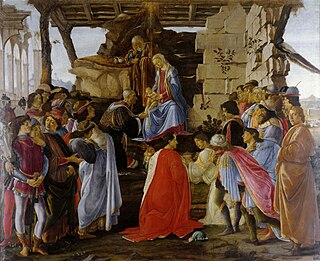
The Adoration of the Magi is a painting by the Italian Renaissance master Sandro Botticelli. Botticelli painted this piece for the altar in Gaspare di Zanobi del Lama's chapel in Santa Maria Novella around 1475. This painting depicts the Biblical story of the Three Magi following a star to find the newborn Jesus. The image of the altarpiece centers on the Virgin Mary and the newborn Jesus, with Saint Joseph behind them. Before them are the three kings who are described in the New Testament story of the Adoration of the Magi. The three kings worship the Christ Child and present him with gifts of gold, frankincense and myrrh. In addition, the Holy Family is surrounded by a group of people who came to see the child who was said to be the son of God.

The Portrait of Lucrezia Panciatichi is an oil on panel painting by the Italian artist Agnolo di Cosimo, known as Bronzino, finished around 1545. It is housed in the Uffizi Gallery in Florence, Italy.
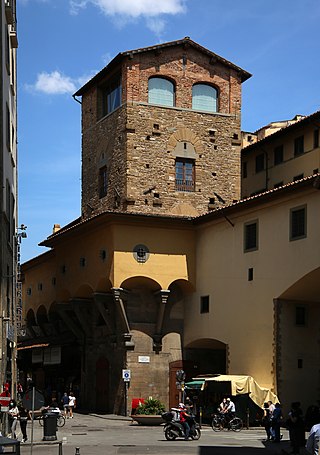
The Torre dei Mannelli is a small tower on the southeast corner of the Ponte Vecchio bridge in Florence, Italy. It is the only survivor of the four towers that once defended each corner of the bridge. In 1565, the Mannelli family refused to have it altered or demolished so that the Vasari Corridor could be built in a straight line. Instead the corridor swerved round it on brackets.

The Lamentation of Christ is an oil-on-panel painting of the common subject of the Lamentation of Christ by the Netherlandish artist Rogier van der Weyden, dating from around 1460–1463 and now in the Uffizi Gallery, Florence, Italy.

Adoration of the Christ Child is an oil on canvas painting by the Italian Renaissance artist Correggio, dating from around 1526 and housed in the Uffizi Gallery of Florence, Italy.

The Panciatichi Holy Family or Panciatichi Madonna and Child is a 1541 oil on panel painting by Bronzino, signed on a stone in the bottom left corner. It is now in the Uffizi in Florence, where it was first recorded in the Tribuna in 1704, where it remained until 2010, when it was moved as part of the "New Uffizi" project. Preparatory drawings for the work are in the Uffizi's Gabinetto dei Disegni e delle Stampe and in the Phillips collection in London.

Portrait of a Young Man is an oil on panel painting by Parmigianino, executed c. 1530, now in the Uffizi in Florence, whose collection it entered on 27 October 1682. Three copies survive in the Museo di Capodimonte, Rome's Accademia di San Luca and the Galleria nazionale di Parma.

Portrait of Cosimo the Elder is an oil on panel painting by Pontormo, executed c. 1519–1520, now in the Uffizi, Florence.

Portrait of Maria Salviati is an oil on panel painting attributed to Pontormo, executed c. 1543–1544, in the Uffizi, Florence.

Nano Morgante was an Italian dwarf who was a famed buffoon and court jester in the court of Cosimo I de' Medici, Grand Duke of Tuscany. Morgante was ironically nicknamed after the giant from the poem of the same name by Luigi Pulci. He was the most celebrated of the five dwarves of the Medici court at the Palazzo Pitti.
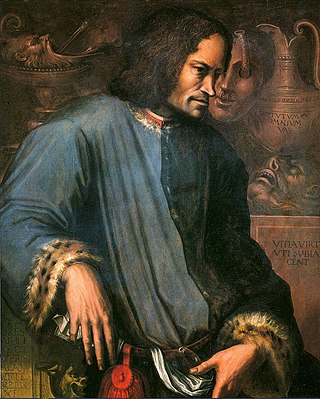
The Portrait of Lorenzo the Magnificent is an oil on wood painting by Italian artist Giorgio Vasari, created around 1534. It is housed in the Uffizi, in Florence.




















